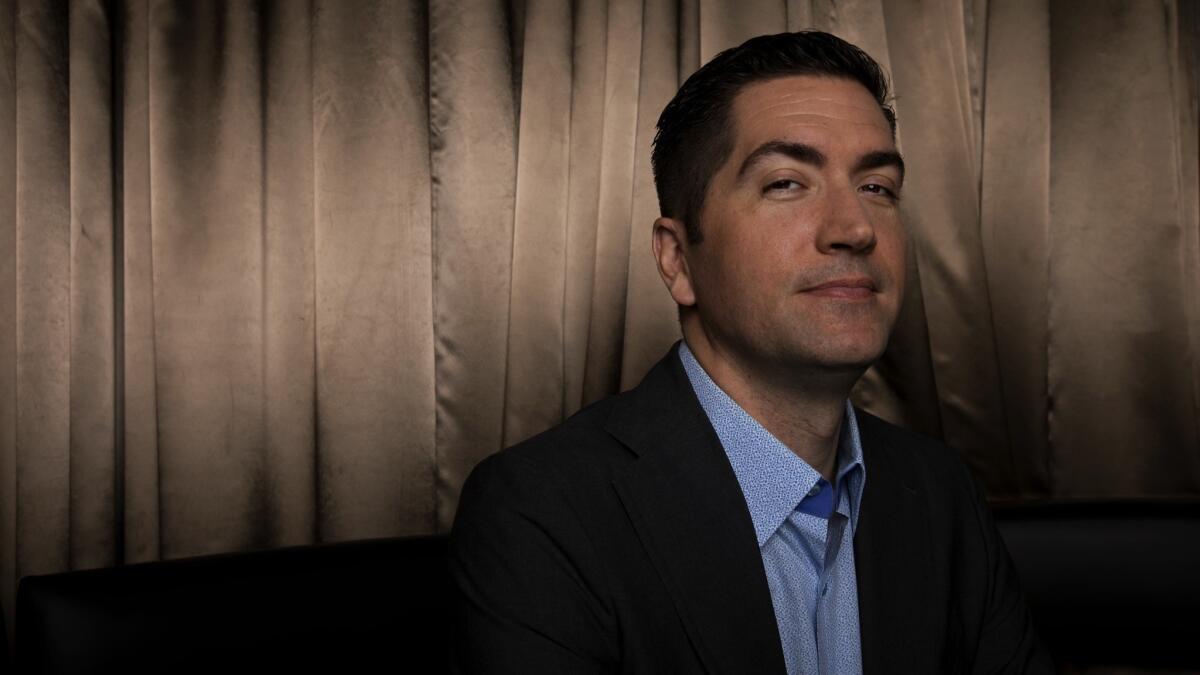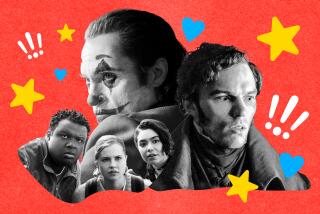‘Bad Times at the El Royale’ writer-director Drew Goddard on an endangered species: an original movie from a Hollywood studio

As a screenwriter and director, Drew Goddard has racked up a virtually unbroken string of success, whether scripting box-office hits like “Cloverfield,” “The Martian” and “World War Z” or directing the critically acclaimed 2012 horror-satire “The Cabin in the Woods.”
But in his own telling, he has flirted with disaster at every turn.
“Here’s the truth: Every movie I’ve done in my career could be viewed as something the industry doesn’t want,” Goddard, 43, said on a recent afternoon at a café in Los Angeles. “It all looks good in hindsight. But at the time, everyone said ‘The Martian’ would never work. Even ‘Cloverfield’ — ‘Oh, you’re going to do some weird “Blair Witch Project” take on Godzilla?’ They all sound like bad ideas in one-sentence form.”
Having cut his teeth early in his career on genre-busting TV series like “Buffy the Vampire Slayer,” “Alias” and “Lost,” Goddard has always been drawn to the type of projects that don’t make for slam-dunk pitch meetings, prefab marketing campaigns or easily digestible sound bites. And his latest film as a writer and director, the crime thriller “Bad Times at the El Royale,” is no exception.
If you’ve only seen, say, a 30-second TV spot for “Bad Times,” which hits theaters Friday, you’d be forgiven if you were left a bit puzzled exactly what it’s about. In fact, a degree of puzzlement is entirely intentional.
In the film, which is set in the late 1960s, seven strangers of varying degrees of repute — including a priest (Jeff Bridges), a vacuum salesman (Jon Hamm), a lounge singer (Cynthia Erivo) and a jaded hippie (Dakota Johnson) — find themselves thrown together in a hotel on the Nevada-California border and … things happen.
There are twists and betrayals, surprising reveals and outbursts of violence. Characters who seem to be one thing turn out to be something else entirely. At some point, Chris Hemsworth shows up as a sinister, frequently shirtless cult leader. It’s probably best not to say more.
“Bad Times at the El Royale” grew out of Goddard’s love of noir films like “Out of the Past” and “Chinatown” and authors like Dashiell Hammett, Graham Greene and Flannery O’Connor. As he was writing the script, he continually tried to subvert the standard plot conventions.
“I don’t like when I know where a story is going: ‘Oh, I guess that’s the third act now,’ ” he said. “Nobody has to watch this movie more than me, so if it gets too straightforward I get bored. These movies take years out of my life so in order to do them, I have to find ways to keep myself guessing. There are a couple of big turns that the movie takes that are because I started to grow tired with the story, and I think it led us to some interesting places.”
Generally favorable reviews should help propel the box office for “Bad Times at the El Royale” (with an assist from bare-chested Hemsworth). But in an era dominated by movies with pre-sold brand awareness, Goddard understands the challenge he’s facing in trying to tantalize moviegoers into coming to see an original story while holding back key details of what exactly they’re paying to see.
“It’s hard,” he said. “I get it — if I’m in my living room, I’d go, ‘You’ve got to tell me more. My time is too valuable.’ I want to give people enough to say, ‘You’re going to like this.’ It’s on me to give the audience a good time. I’m not out to make my weird art film.”
Budgeted at $32 million, “Bad Times at the El Royale,” on paper, is the kind of movie that is supposed to be an endangered species in today’s studio system: a smart, midrange film aimed at grown-ups that’s not based on any existing property. That’s largely what drew Bridges — who came up in the 1970s, when such movies were the norm rather than the exception — to the project.
“That midbudget movie — the movie that’s not a $200-million movie and it isn’t a $10-million movie — is starting to go the way of the dinosaur,” Bridges said. “I’m hoping it comes back. This is the kind of movie that I love to see and be in as well — those movies where the filmmakers are ahead of you and you don’t know what the hell is going to happen.”
For his part, Goddard argues that the reports of the death of the midrange adult movie have been greatly exaggerated.
“You keep hearing, ‘Nobody is making movies for grown-ups’ — but they are,” he said. “I reject this idea that there’s a groupthink. When I look at the studios, they all want content. That’s what drives them. The trick is to be responsible about it, to give them content in an affordable way and understand from their point of view what they need.”
Indeed, there was strong interest from almost every studio in town for Goddard’s spec script for the film. “It was one of those days you always hear about where suddenly I’m in different rooms with people pushing pieces of paper across tables in very cinematic ways at me and saying, ‘We want this. What do we have to do?’ ” he said. “It was fun.”
“Bad Times” producer Jeremy Latcham hopes that the film’s relative uniqueness in a landscape dominated by sequels, spinoffs and reboots will draw audiences hungry for something new.
“The midrange budget stuff that does kind of squeak through, a lot of it you feel like you’ve seen before — it’s a straight thriller, a straight action picture or a straight drama or biopic or whatever,” Latcham said. “But I think studios will always want to make stuff that’s good and exciting and thrilling and fresh, and I think this movie falls into those categories.”
REVIEW: Twisty motel noir ‘Bad Times at the El Royale’ nearly overstays its welcome »
Goddard — who has also directed episodes of the NBC comedy “The Good Place,” on which he is an executive producer — is quick to note that he doesn’t have anything against giant franchise movies per se. In fact, after “Bad Times at the El Royale,” he is slated to take on the comic-book movie “X-Force,” a spinoff of the “Deadpool” series.
For the moment, details on that project are still under wraps. “[‘Deadpool’ star] Ryan [Reynolds] and I came up with some really good ideas that got me really excited,” Goddard says. “But I was very clear with them that I had to do ‘Bad Times’ first so I couldn’t really even engage on what [‘X-Force’] is going to be, but let’s keep thinking about it. That’s kind of where we are now.”
But even as prepares to take on what would be by far his biggest movie to date — the kind of brass ring that many directors are dying to reach — Goddard says he’s prepared to let “X-Force” go if it ultimately doesn’t feel like the right fit for his particular sensibility.
“We will get to a point where I’ll say, ‘This is the movie I see — do you guys think this is going to fulfill what you need it to fulfill? If the answer is no, let’s walk away,’ ” Goddard said. “The only way I ever end up miserable in this business is when I’m actually making something and we’re not on the same page about it.”
For now, Goddard is focused on launching “Bad Times at the El Royale” into the world, then recharging his creative battery and seeing where his curiosity takes him, whether it fits with the conventional wisdom or not.
“The truth is, I’ve found it’s best to just write what you want to see and hope for the best,” he said. “You sort of hope that your batting average is high enough that you can take some crazy swings and not listen to the noise. Because otherwise you’ll start to self-edit and say, ‘I guess I’ll just give them what they want.’ And I’ve found that makes me unhappy in my career.
“I look forward to getting back to the blank page, which is something I never say,” he continued. “As a writer, the blank page is the worst. The fact that I’m excited to get back to it is a good sign.”
Twitter: @joshrottenberg
More to Read
Only good movies
Get the Indie Focus newsletter, Mark Olsen's weekly guide to the world of cinema.
You may occasionally receive promotional content from the Los Angeles Times.











